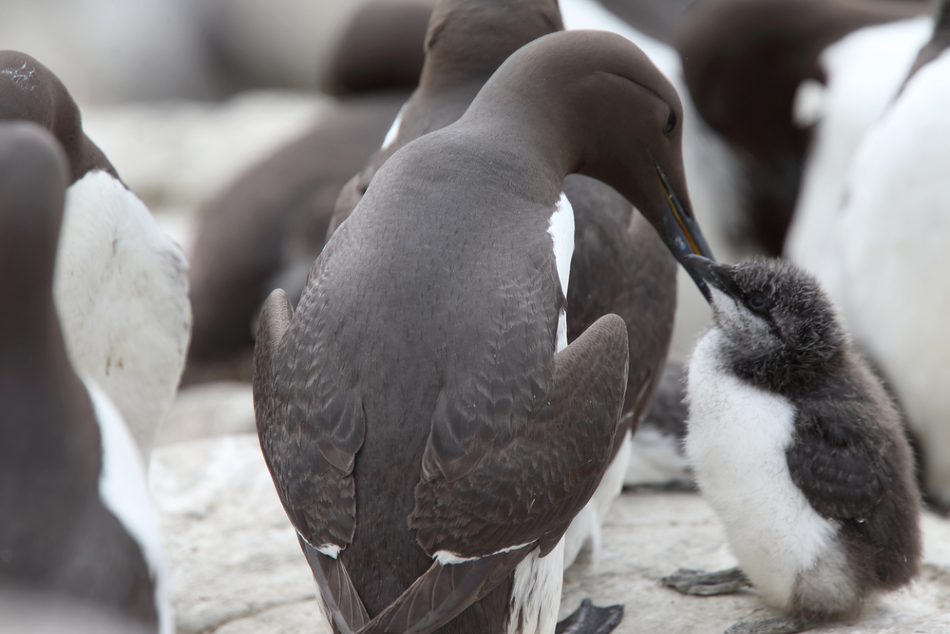A record-breaking area of unusually warm water known as ‘the blob’ is thought to have been responsible for the deaths of around one million seabirds. Between the years 2013 and 2016, this patch of water lurked off the coast of North America. In 2015, waves of Common Murres (uria aalge) began to wash up on shores from Alaska to California.

Rapod increases in ocean temperatures are believed to have caused mass deaths in the Common Murre. Image Credit: tony mills/Shutterstock.com
From the fall of 2015 to summer 2016, around 62,000 Common Murres carcasses were on the shores of North America. Researchers concluded that the birds died of starvation and their data was used to hypothesize that up to one million seabirds may have perished during the period of increased water temperatures.
“The amazing question is, how could a million die over 6000 kilometers, pretty much all at the same time, and what could cause it."
John Piatt, US Geological Survey
Published in the journal PLOS ONE, scientists working for various institutions and bird rescue centers analyzed a series of surveys and data to conclude that the rippling effect of ‘the blob’ on the marine food web is what caused the mass deaths. Events such as this are expected to become more common due to climate change, as other reports also point towards the catastrophic consequences of the warming of the oceans.
With the marine food web under stress, Piatt and his team surveyed the data from sea surface temperature, fisheries, and records of beached murres. It is believed that due to rapid increases in water temperature, certain fish species such as cod consume more of the prey that the murres rely on. Furthermore, the appearance of fish species attracted to warmer waters coupled with the fact cold-blooded fish species need to eat more food to regulate their body temperatures in the warming waters put further strain on the food web.
“A whole new ecosystem was establishing itself all the way up the food chain,” said Julia Parrish, professor of marine sciences at the University of Washington and a co-author of the study.
Extreme mortality in Common Murres
However, while it wasn’t just the murres affected by the event, as tufted puffins, sea lions and baleen whales also died during this period, the case of the Common Murres is considered to be most unusual. Particularly because one of the largest mass die-offs on record has impacted one of the most well-adapted seabirds. Common Murres can fly faster and further than most other seabirds and have the agility to capture fast-moving prey at greater depths than other bird species.
"Murres are the ultimate predator—they're extremely well adapted, they can dive to 200 meters, and they live on the Continental Shelf," said Piatt. "Anywhere along there is their domain. And they're the fastest flying sea bird," he added.
With up to 20% of the total population starving during the intensified period of warmer waters, the researchers were compelled to analyze the event further with federal agencies joining the study to increase the reach of the survey. The scientists conducting the study reached out to bird rescue and rehabilitation centers along the US west coast, and 37 of the 66 that responded indicated increased numbers of injured or dead murres.
During the study, the scientists investigated other factors that may have caused the mass deaths, including the idea that toxic algae blooms, spawned by the blob, could be responsible. Scientists also ruled out any disease that could be a public health risk.
“It’s very convincing, and I would actually say it’s fairly conclusive. There’s very little else that could have caused the extensive effects they document,” says Andrew Leising at the US National Oceanic and Atmospheric Administration.
Rapidly warming oceans
According to the UN climate science panel, climate change means that the occurrence of ocean heatwaves will become more common. Furthermore, the National Oceanic and Atmospheric Administration (NOAA) has reported that there is evidence that the blob could have returned. While the latest patch covers a smaller area meaning the impact on the marine food web could be less severe, scientists are erring on the side of caution as it could be months later when the repercussions are felt.
Although Common Murres are not under an immediate threat of extinction, it could take years before the US west-coast populations recover. “These heatwaves are going to have jarring effects on our ecosystems,” said Piatt.
Ocean warming is accelerating at an unprecedented pace and the rapid warming of seawaters could have dire consequences as the planets waters historically absorb excess heat. Therefore, if the ocean continues to warm at the current rate, they will be unable to absorb any excess heat and the land surface will heat up much faster. With recent reports confirming the role of climate change in the Australian Wildfires, mass die-offs, and increases in extreme weather events, we could be gaining further insight into what the planet’s future may look like on a more permanent basis.
Disclaimer: The views expressed here are those of the author expressed in their private capacity and do not necessarily represent the views of AZoM.com Limited T/A AZoNetwork the owner and operator of this website. This disclaimer forms part of the Terms and conditions of use of this website.